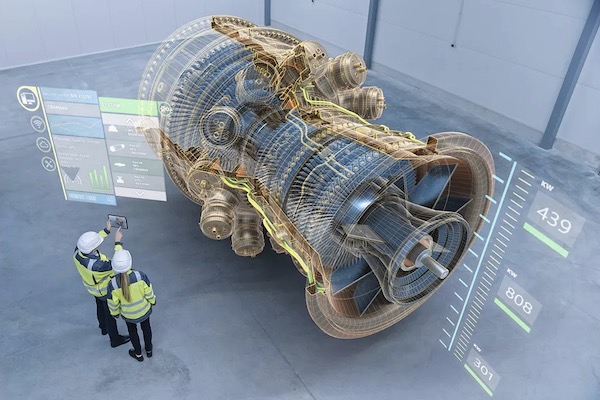Published on the 07/06/2023 | Written by Heather Wright

NZ joins AU in Digital Twin Partnership
Private sector digital twin efforts have a new advocate with the launch of the Kiwi arm of the trans-Tasman Digital Twin Partnership.
Digital Twin Partnership launched in Australia last year in an effort to provide industry leadership within the private sector and advocate for greater investment, policy and industry capability. The Kiwi arm announced its launch last week, with the first launch event held this week.
Digital twins – a digital representation of a physical object, whether a product, manufacturing facility, electricity grid, entire city or even a customer, with near-real-time data and feedback loops – have been hailed in recent years as a way to reduce development times and cost, enabling rapid iterations and optimisation without physical testing. In manufacturing, they’ve become a key topic for Industry 4.0.
“We face a myriad of big challenges and see the power a digital twin approach can bring.”
An IoT Analytics report in March said the market for digital twins grew 71 percent between 2020 and 2022, with 63 percent of manufacturers developing, or planning to develop, a twin. The market, however, is yet to reach its full potential, IoT Analytics says. It expects future growth to be more aggressively driven by manufacturers across the East Asia and Pacific region.
The Digital Strategy for Aotearoa roadmap includes a national digital twin infrastructure and interoperability initiative for 2025, though the work is not yet funded or committed into the work program. The Industry 4.0 Demonstration Network, an initiative by Callaghan Innovation, Beca and the EMA, is also encouraging Kiwi manufacturers to embrace new technology such as digital twins.
But while Standards Australia says digital twins are likely to have ‘a profound impact on how we work, live and play’, it’s also flagged some key issues to be addressed.
The standards development organisation, which recently released a Digital Twin White Paper, notes that digital twins are suffering a fate similar to other technologies, with a lack of guidance and definition on what best practice process looks like.
It notes mixed interpretations of the core concepts and terminology, varying levels of understanding and application of the use cases and benefits and a struggling marketplace that is uncertain how to mobilise.
That’s something the Digital Twin Partnership will be hoping to rectify.
A Digital Twin Partnership (DTP) survey, carried out at its Brisbane launch event late last year, saw strong support for DTP to provide advocacy, community building and a clear narrative around digital twins, while on the technical side, attendees said DTP could help accelerate their twin initiatives through standards development and data and knowledge sharing.
The survey found understanding the value and benefits were a key hinderance for attendees uptake of digital twins. And, despite those attending likely being more informed about digital twins than many, a significant proportion said they didn’t know where to start.
Kat Salm, one of the Digital Twin Partnership New Zealand (DTP-NZ) leadership team and head of digital at engineering firm Harrison Grierson, says “We face a myriad of big challenges and see the power that a digital twin approach can bring to helping solve these complex problems and informing better decision making.”
The Digital Twin Partnership is one of a number of industry groups, including the Digital Twin Consortium and Smart Cities Council, who touch on digital twins, but says its sole focus is on leadership and advocacy for the digital twin market.
Like its Australian counterpart, DTP-NZ will focus on advocacy, building capability through collaboration, innovation and standardisation, and bringing together a community of stakeholders to share and learn.
Chau Nguyen, DTP-NZ leadership team member and digital solutions advisory client director for engineering firm WSP New Zealand, says digital twins have the potential to be a game changer for all industries, empowering New Zealand to be more resilient.
“New Zealand is renowned for innovation and has world-leading digital twin programs with diverse use cases that will drive economic benefit, assist decision-making for infrastructure investment, aid in adaptation planning for climate change and develop resilience to natural disasters,” she says.
While the Digital Twin Partnership is focusing on the private sector, it’s public funding dollars that seem to be pouring into digital twins, particularly in Australia.
Victoria unveiled its AU$37.4 million digital twin last year, while New South Wales’ has a $40 million Spatial Digital Twin and Wellington City Council won a global prize for innovation in 2022. Queensland and Western Australia are also on the digital twin path.
Local governments, including the City of Melbourne, Hobart, Launceston and Western Sydney are also looking at how digital twins can enable better services and asset owners, including the Victorian Department of Transport and Sydney Metro are doing the same. Sydney Water is also working on digital twins to both modify and build new assets more efficiently and cost-effectively.
Swinburne, meanwhile, has teamed up with Siemens to create a digital twin of Australia’s energy grid which will enable developers to use digital twins of energy grids, map scenarios, research new findings, develop hypothese and test results.
The Digital Twin Partnership is expected to expand its reach into North America soon.



























